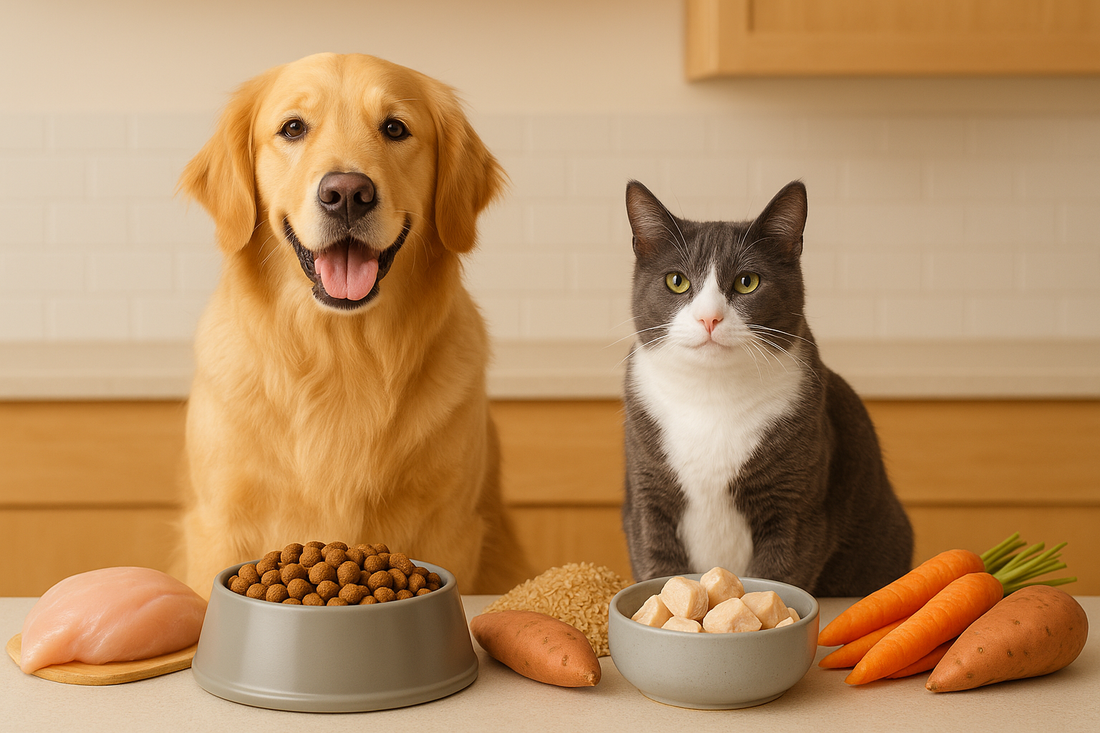
Choosing the Right Food for Your Dog or Cat: A Practical Guide for Pet Owners
Share
Selecting the right food for your dog or cat is one of the most important decisions you’ll make as a pet owner. Proper nutrition supports a healthy immune system, strong bones and joints, a shiny coat, and overall longevity. However, with so many options on the market, it can be difficult to know where to start. This guide breaks down the essential factors to consider when choosing the best diet for your furry companion.
1. Consider Age and Life Stage
Dogs and cats have different nutritional needs at each stage of life.
-
Puppies and kittens require food rich in protein, fat, calcium, and calories to support rapid growth and development.
-
Adult pets need a balanced formula to maintain muscle, energy, and weight.
-
Senior pets may benefit from lower-calorie diets with added joint support and easier digestibility.
Check the label for life-stage-appropriate indicators such as “puppy,” “kitten,” “adult maintenance,” or “senior formula.”
2. Match to Breed Size and Activity Level
Nutritional requirements can vary based on breed size, particularly in dogs:
-
Small breeds tend to have faster metabolisms and may benefit from calorie-dense kibble in smaller pieces.
-
Large breeds are prone to joint issues and may require controlled calcium and phosphorus levels to support bone health.
Highly active or working dogs typically need higher-protein formulas, while less active indoor pets may need reduced-calorie options to avoid obesity.
3. Understand Ingredients and Nutritional Quality
A high-quality pet food should contain:
-
Whole animal protein (e.g., chicken, beef, fish) listed as the first ingredient
-
Wholesome grains (e.g., brown rice, oats) or grain alternatives (e.g., sweet potatoes, lentils)
-
Natural fats and oils, such as chicken fat or fish oil for healthy skin and coat
Avoid:
-
Meat by-products of unspecified origin
-
Artificial colors or preservatives
-
Corn, wheat, and soy fillers (especially if your pet has sensitivities)
Look for foods that meet AAFCO (Association of American Feed Control Officials) nutritional standards — this ensures complete and balanced nutrition.
4. Address Health Concerns or Dietary Sensitivities
Many pets today experience food-related issues such as:
-
Allergies or skin irritation
-
Digestive upset (e.g., gas, diarrhea)
-
Frequent itching or paw licking
In these cases, consider:
-
Limited ingredient diets with fewer protein and carb sources
-
Grain-free options (though not always necessary — consult your vet)
-
Novel protein formulas like duck, lamb, or venison
-
Probiotics and prebiotics to promote gut health
Always introduce new foods gradually to prevent stomach upset.
5. Choosing Between Dry, Wet, and Fresh Food
Each type of food has its benefits:
| Type | Pros | Cons |
|---|---|---|
| Dry (Kibble) | Cost-effective, long shelf life, helps with dental health | May be less palatable for picky eaters |
| Wet (Canned) | Higher moisture content, good for hydration | More expensive, less convenient to store |
| Fresh/Raw | Minimally processed, often more nutrient-rich | Requires refrigeration and may have shorter shelf life |
For many pet owners, a mix of dry and wet food offers a good balance of nutrition and variety.
6. Check Product Labels and Brand Reputation
When choosing pet food, read the guaranteed analysis and ingredient panel closely. Look for:
-
Real meat proteins in the top three ingredients
-
Transparent sourcing and manufacturing practices
-
Positive reviews from other pet owners
-
Certifications like USDA Organic or AAFCO approval
Brands that offer clear, detailed information about their formulas tend to be more trustworthy.
7. When in Doubt, Talk to a Veterinarian
Each pet is unique, and while general guidelines are helpful, specific dietary needs may vary based on breed, medical history, or even lifestyle. If you're unsure about which food is right for your pet, consult a veterinarian — especially before switching to a specialized or raw diet.
Final Thoughts
Feeding your dog or cat a high-quality diet is one of the most effective ways to support their long-term health and happiness. By considering life stage, activity level, ingredient quality, and individual health concerns, you can make a well-informed choice that meets your pet’s needs.
The pet food market is evolving rapidly, with more nutritious and transparent options than ever. Take your time, do your research, and choose what’s best for your four-legged friend.